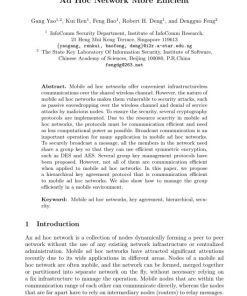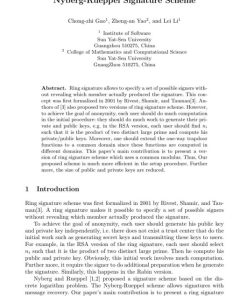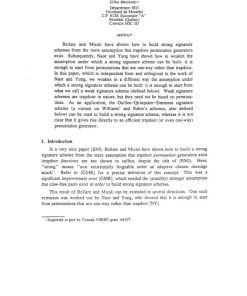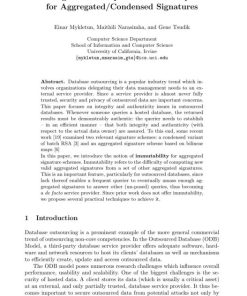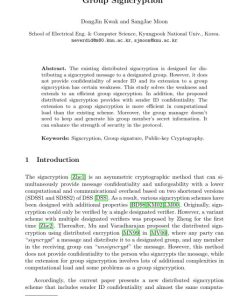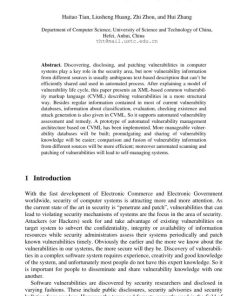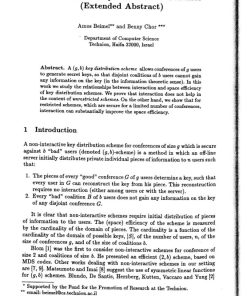Generalized Key Evolving Signature Schemes or How to Foil an Armed Adversary 1st edition by Gene Itkis, Peng Xie ISBN 3540202080 9783540202080
$50.00 Original price was: $50.00.$25.00Current price is: $25.00.
Authors:Gene Itkis; Peng Xie , Tags:Applied Cryptography and Network Security , Author sort:Itkis, Gene & Xie, Peng , Languages:Languages:eng , Published:Published:Aug 2003
Generalized Key-Evolving Signature Schemes or How to Foil an Armed Adversary 1st edition by Gene Itkis, Peng Xie – Ebook PDF Instant Download/Delivery. 3540202080, 978-3540202080
Full download Generalized Key-Evolving Signature Schemes or How to Foil an Armed Adversary 1st Edition after payment

Product details:
ISBN 10: 3540202080
ISBN 13: 978-3540202080
Author: Gene Itkis, Peng Xie
Key exposures, known or inconspicuous, are a real security threat. Recovery mechanisms from such exposures are required. For digital signatures such a recovery should ideally – and when possible – include invalidation of the signatures issued with the compromised keys. We present new signature schemes with such recovery capabilities.
We consider two models for key exposures: full and partial reveal. In the first, a key exposure reveals all the secrets currently existing in the system. This model is suitable for the pessimistic inconspicuous exposures scenario. The partial reveal model permits the signer to conceal some information under exposure: e.g., under coercive exposures the signer is able to reveal a “fake” secret key.
We propose a definition of generalized key-evolving signature scheme, which unifies forward-security and security against the coercive and inconspicuous key exposures (previously considered separately [5,18,11]).
The new models help us address repudiation problems inherent in the monotone signatures [18], and achieve performance improvements.
Generalized Key-Evolving Signature Schemes or How to Foil an Armed Adversary 1st Table of contents:
-
Introduction
- 1.1 Motivation for Key-Evolving Signature Schemes
- 1.2 The Threat Model: Armed Adversaries and Attacks
- 1.3 Key Challenges in Designing Robust Signature Schemes
- 1.4 Objectives of the Paper
- 1.5 Structure of the Paper
-
Background and Related Work
- 2.1 Overview of Digital Signature Schemes
- 2.2 Classical Signature Schemes: RSA, DSA, and ECDSA
- 2.3 Evolution of Signature Schemes: Key-Evolving and Dynamic Models
- 2.4 Attacks on Signature Schemes: Forgery, Replay, and Impersonation
- 2.5 Existing Work on Key-Evolving Signature Schemes
- 2.6 Limitations of Current Approaches
-
Preliminaries
- 3.1 Mathematical Foundations: Cryptographic Assumptions and Models
- 3.2 Definition of Key-Evolving Signature Schemes
- 3.3 Security Notions for Signature Schemes
- 3.4 Formal Security Definitions for the Proposed Scheme
- 3.5 Overview of the Evolutionary Key Concept
-
Proposed Generalized Key-Evolving Signature Scheme
- 4.1 Overview of the Scheme
- 4.2 Key Generation and Evolution Process
- 4.3 Signing and Verification Procedures
- 4.4 Integration with Existing Cryptographic Protocols
- 4.5 Handling Key Rotation and Updates
- 4.6 Adaptive Security Features to Counter Armed Adversaries
- 4.7 Efficiency Considerations and Optimizations
-
Security Analysis
- 5.1 Security Goals for Key-Evolving Signature Schemes
- 5.2 Formal Security Proofs: Unforgeability and Resistance to Attacks
- 5.3 Analysis of Resilience Against Armed Adversaries
- 5.4 Key Leakage, Collusion, and Misuse Resistance
- 5.5 Comparative Security Analysis with Traditional Signature Schemes
- 5.6 Security Considerations for Real-World Deployments
-
Performance Evaluation
- 6.1 Computational Complexity of the Scheme
- 6.2 Efficiency in Key Generation, Signing, and Verification
- 6.3 Scalability of the Key-Evolving Scheme in Large Systems
- 6.4 Experimental Results: Latency, Throughput, and Resource Utilization
- 6.5 Comparison with Existing Signature Schemes
-
Applications and Use Cases
- 7.1 Digital Transactions and E-commerce Systems
- 7.2 Secure Software Distribution and Updates
- 7.3 Cryptographic Proofs in Blockchain and Cryptocurrencies
- 7.4 Multi-party Authentication and Secure Communication Protocols
- 7.5 Government and Legal Applications: Digital Signatures in Legal Contexts
-
Challenges and Limitations
- 8.1 Key Management and Distribution Challenges
- 8.2 Addressing Key Compromise and Revocation
- 8.3 Balancing Security and Efficiency in Resource-Constrained Environments
- 8.4 Mitigating the Impact of Adversaries with Advanced Capabilities
- 8.5 Scalability in Large-Scale Systems with Frequent Key Updates
-
Future Directions
- 9.1 Improvements in Key-Evolving Algorithms for Enhanced Security
- 9.2 Integration with Blockchain for Distributed Key Management
- 9.3 Exploring Hybrid Cryptographic Techniques for Signature Schemes
- 9.4 Adaptations to Quantum-Resistant Signature Schemes
- 9.5 Handling Real-Time Dynamic Threats in Emerging Technologies
-
Conclusion
- 10.1 Summary of Contributions and Findings
- 10.2 Impact of Key-Evolving Signature Schemes on Security Practices
- 10.3 Final Remarks on Defeating Armed Adversaries with Advanced Cryptographic Techniques
People also search for Generalized Key-Evolving Signature Schemes or How to Foil an Armed Adversary 1st:
generalized knowledge
generalized concatenation key derivation function
b key signature treble clef
c major key signature piano
f major key signature violin



